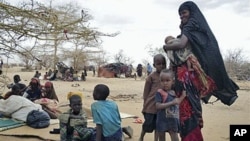Eighteen months ago, the United States, along with many in the international community, recognized the developing humanitarian disaster in the Horn of Africa and began to move resources around the region. Thus, when the United Nations declared a famine in parts of Somalia six months ago, we were ready to ramp up our response to the crisis even more, according to Deputy Assistant Secretary for Public Diplomacy for the Bureau of African Affairs Bruce Wharton. He went on to note that the emergency situation continues:
“In spite of the great work that the United States and the international community have done in that last 18 months. . . . there are still a little over 13 million people in the Horn who are in need of emergency assistance,” he said at a recent briefing.
Some 955,000 Somalis have been displaced in the Horn of Africa (some for as long as 20 years), according to Acting Assistant Secretary for Population, Refugees, and Migration David Robinson. The generosity and the hospitality of Somalia’s neighbors, most of whom are suffering from drought themselves, have been critical to ensuring that more people haven’t died in this crisis. The flow has slowed down, but refugees are still attempting to leave Somalia.
“Our response to the flow in this past year was to increase our funding significantly in neighboring countries, principally in Ethiopia, Kenya, and Djibouti,” said Assistant Secretary Robinson.
The United States is proud to be the largest humanitarian donor to the region. “We’re up to about $870 million so far in the last year and a half, and about $205 million of that has gone specifically for Somalia,” said Deputy Assistant Secretary Wharton.
“The international response to the humanitarian emergency in Somalia was significantly complicated and slowed by the actions of al-Shabaab and other armed groups. So we will continue to work with regional governments, international partners, and humanitarian organizations to meet the short-term emergency needs. We’ll also work with regional governments and others to establish longer-term food security assurance, and we’ll continue to work on the fundamental need for stable, secure, and citizen-focused governance in Somalia as the longest-term solution to this crisis,” said Deputy Assistant Secretary Wharton.
“Ultimately, though . . . the answer to humanitarian crises in Somalia is going to be the establishment of secure and stable governance in [Somalia], governance that respects human rights and the basic needs of the population.”
Horn Of Africa Famine Six Months Later

The United States has ramped up its response to the crisis but the emergency still continues.


















